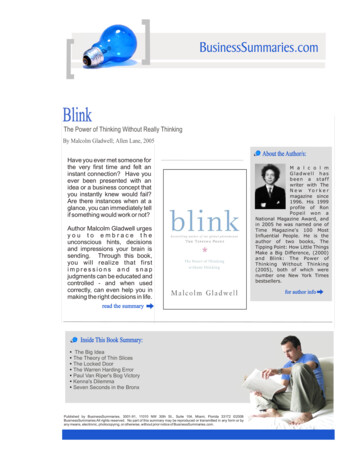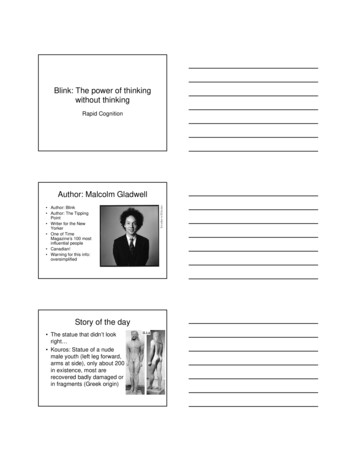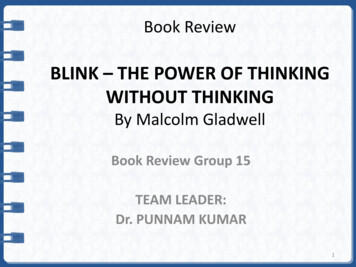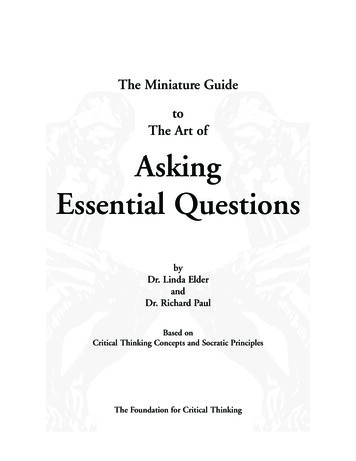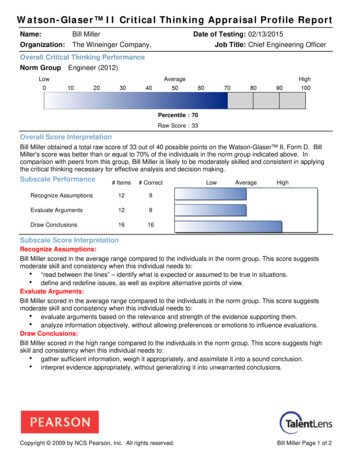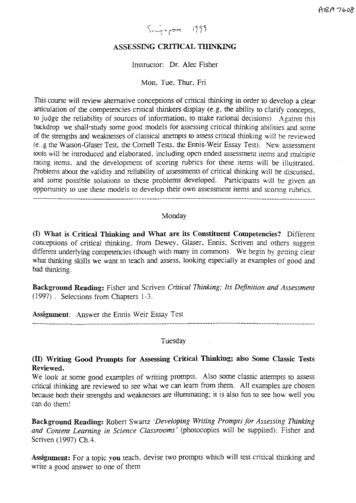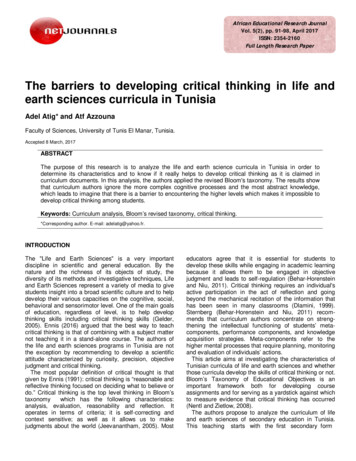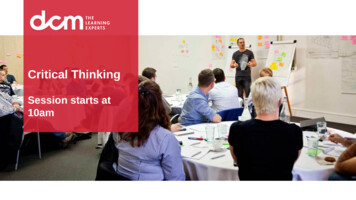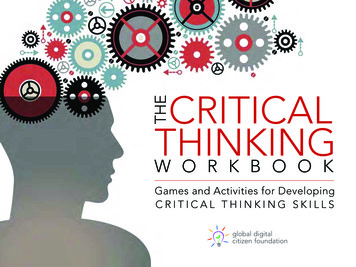
Transcription
THECRITICALTHINKINGW O R K B O O KGames and Activities for DevelopingCRITICAL THINKING SKILLS
What isCritical Thinking?Critical thinking is clear, rational, logical, andindependent thinking. It’s about improving thinkingby analyzing, assessing, and reconstructing how wethink. It also means thinking in a self-regulated andself-corrective manner. It’s thinking on purpose!Critical thinking involves mindful communication,problem-solving, and a freedom from bias oregocentric tendency. You can apply criticalthinking to any kind of subject, problem,or situation you choose.About This WorkbookThe activity pages in the Critical ThinkingWorkbook are meant to be shared and explored.Use it as an electronic document or as worksheets.You can either print off the pages and use them asactivity sheets, or you can edit them directly right inthe document on your computer.There are also Answer Keys for the activitiesthat need them provided at the back ofthe book. Now, go get thinking!
Activities forCOMMUNICATION
?FACT orOPINIONThis exercise is about differentiating between fact and opinion. A fact can be proven either true orfalse. An opinion is an expression of feeling or point-of-view and cannot be proven true or false.The teacher will create some statements that are either fact or opinion. If it’s a fact, check on F and thenbriefly explain how it can be proven. If it’s an opinion, check on O and briefly explain why you feel it can’tbe proven. Compare answers with your friends and share your views with each OFOFOFOFOFOFOFOFO
COFFEEHOUSECHATUse this one for role-playing and interpersonal communication skills. Fill out the character sheetbelow to create a persona. Next, the class should be given an historical event or current issuerelated to the lesson to discuss. Students should also get some time to do some research, and tothink about how they want to represent their character’s views.The class will split into groups. What follows will be a 20 min. cafe-style conversation about thechosen topic. Be sure to practice things like being open-minded and disagreeing respectfully.Character Name: Age: Gender: Marital Status:Occupation: Education Level: Hobbies:Create a brief background for your character:Research notes for your chat:
WORLDLYWORDSWork on some skills using metaphor and choosing words carefully with this fun, challenging exercise.Imagine you live in a world where there are only 10 words you can ever use. You can repeat them asmuch as you want, but you can’t ever use any other words. Write down the 10 words you’d choose.Next, make sentences with them in order to communicate something to your group. Use feeling and gestureto help them understand you. You can measure their understanding by writing your actual intendedmeaning below the sentence. Remember, you’ve only got 10 words to use, so choose them well!Your 10 words:Create sentences with them here:1.1.2.3.4.Actual meaning:2.Actual meaning:3.5.Actual meaning:6.4.7.8.9.10.Actual meaning:5.Actual meaning:6.Actual meaning:
ALIENTRAVELGUIDEThis exercise encourages us to look much deeper at who we are both as individuals and as a society.It’s about looking at what we do or what we value with a fresh perspective.Each activity encourages you to answer the questions as a way of exploring assumptions and somecommon situations in life that we take for granted. There are 2 scenarios provided. The blank spaceis so that you can write your own. You can test your fellow classmates with your scenarios in stylizedinterview sessions where one of you is the alien and the other is the travel guide.Scenario 1Scenario 2Scenario 3You are conducting a tour for aliens whoare visiting earth and observing humans.You’re all in their spaceship when you flyover a football stadium. One of the aliensis confused, and turns to you for help. Tryanswering these questions:You are chatting with a group of alienson a tour of a local library. While you allmingle, one of the aliens picks up avolume about the history of global warand conflict. The alien turns to you andasks you these questions:What is a game, and why do humansplay them?What is war and why do humanswage it upon each other?What are “teams” and why are they soimportant for humans to be part of?Humans seem to feel that warfare isoften the only way to resolve conflict.Why is this so?Why is it these games seem to getmore attention than other matters onyour planet, like disease and poverty?Why do humans get so emotionaland even violent when watchinggames?What would happen if no humancould ever play these games again?How do you decide who wins andwho loses? How do you know this isaccurate?How does warfare affect those whocan’t or won’t participate?What legacy do you feel these wars willprovide for your future generations?
TALK ITOUTTime for some great debates! In this exercise, students will learn the importance of being able to take astance on an issue and defending that stance with logic, reasoning, knowledge, and common sense.Below is a list of scenarios to present for students to discuss and debate. They are based primarily on ethicsand morality. They will encourage students to take a stand and defend their viewpoint. These can be done inpairs, but are much more compelling in larger class debates where views are divided. They can also be usedas individual worksheets—students can circle an answer and then explain their choice in writing.1. Richard finds an expensive looking ring in the school hallway one day. It has no name on it, and it’s not near anyone’s locker.Should he: A) Give it to lost and found B) Ask if it belongs to anyone there C) Keep it and not say anything2. Judy’s friend is stressed about an upcoming test. Judy already took the test and got 100%, so she knows all the answers already.Should she: A) Just give the answers to her friend B) Use her knowledge to coach her friend C) Not get involved at all3. Coach Nelson has caught two of his star basketball players vandalizing school property. The rule is that they must be suspended.If that happens their team loses the upcoming semi-finals. If the coach keeps quiet they’ll surely win, but he could lose his job.Should the coach: A) Suspend the two players and obey the rules B) Pretend he never saw them4. Nick overhears two students bragging about having posted some inappropriate images of a female student online for a joke.Should he: A) Mind his own business B) Report the incident to the school principal C) Confront the boys and defend the student5. You witness a bank robbery, and follow the perpetrator down an alleyway. He stops at an orphanage and gives them all the money.Would you: A) Report the man to police since he committed a crime B) Leave him alone because you saw him do a good deed6. A friend tells you that he/she has been receiving anonymous bullying messages online. You suspect that certain people are guilty.Would you: A) Tell your friend just to ignore them B) Encourage them to report the abuse C) Risk confronting the ones you suspect
SILENTSHARINGHere is an exercise for visualization and non-verbal communication. It involves conversing with writingand drawing to develop reflection and deliberate thinking.Break into groups of 2 or 3. Each person gets their own sheet (or create one big one for the team). Theteacher will provide an essential driving question to ponder. Write it at the top of the sheet. Next, reflecton the question and then begin “talking” about it using only writing and sketching in your space.The Essential Question:
ELEVATORPITCHThis is an exercise used in business to help you think fast and get your point across. It’s all aboutchoosing and using words carefully and persuasively to achieve your goals in any conversation.You must convincingly “pitch” an idea, concept, product/service or proposal in the time it takes to ridean elevator (about 30 to 60 seconds) so this is a timed exercise. Make some notes about what you wantto say; some topic ideas and note space are provided below. Enjoy the ride!Ideas for EP TopicsA product or service you are offeringAn idea for a website/social networkMy Topic:A special project you need to fundA favour you need from someoneAn organization or business planAn invention you want to get patentedA party plan for a birthday/weddingA campaign for a political positionAn advertisement for a local eventAn idea for a blog or a bookA unique interior design for a space
Activities forTHINKING VISUALLY
REBUSROUNDUPRebus puzzles use visuals that put a different spin on words or parts of words that are well known.Figure out the word or phrase for each of these rebus puzzles and write it underneath.ANOTHERDECI SIONAGE AGE AGECHIEDITOREFT CRET16ED12O ER T O17PHROMATE13GETand betterGO18SHOWand better10 ACMORALGET ITGET ITGET ITGET 915JACK20
TOTAL RECALLLook at the objects and words on the page for 1 minute. Next, try to write down everything youremember seeing and reading on the page. If you’re doing this one as a colour print-off, try recallingthe specific colour of each word and shape too, if you mages: www.freepik.comSUNGLASSES
4/9 CONNECTConnect these 9 dots using only four lines, and without lifting your pencil from the paper.(Hint: Think beyond real and imaginary boundaries with this puzzle.)
CRAZYCAPTIONSPut in your own creative wording for each of these images. You can write some dialog between thecharacters, write a single-line caption, or turn the image into a clever meme. Keep it short and witty!
MEANINGSIN MINDWrite one sentence to explain what each common image or symbol means to you. The idea here is tomove away from conventional meanings and relate to the images personally.
AWESOMEANAGRAMSAnagrams are words and sentences that can be written different ways to obtain more words or groupsof words. Create new words by rearranging the letters in the ones below—some can be RAINPASSTEAMEAST
Activities forINDIVIDUAL SKILLS
YOU NAME ITAnswer each question for each list below. To make it more challenging, try answering as quicklyas you can against another person.Name 3 people that:Name 3 places that:Name 3 things that:1. Talk more than you1. Have good food1. Are square2. Talk less than you2. You would like to visit2. Are orange3. Work hard3. Have lots of mountains3. Smell good4. You think are smart4. Are always warm4. Live in the water5. Wear costumes5. You don’t want to visit ever5. Taste terrible6. Are teachers6. Are not on Earth6. You enjoy doing7. Travel a lot7. Have a lot of technology7. You don’t enjoy doing8. Are always nice to you8. People haven’t fought in wars8. People read9. Have a job you’d love to do9. Have a lot of pollution9. You see at school every day10. Are very creative10. Are famous all over the world10. Scare you
1001 WAYSThis is a brainstorming exercise. The class writes everyday objects on slips of paper and places all theslips in a box. You each draw a slip from the box, and the activity begins on a 15 min. timer. You mustnow come up with as many new uses for your object as you can. Write them down or sketch themout in the box—be as creative as you can! (You can also do this exercise in pairs or groups)My Object:
WHAT WOULDHAPPEN?This exercise is designed to help you think laterally and discover new ways of looking at theworld. Answer these questions using creative and constructive thinking. You can use as muchdetail as you like. For fun, try to think of your own “What Would Happen?” questions!What would happen if there were suddenly no computers, tablets, or phones of any kind anywhere on Earth? we had to live in a world without electricity? you woke up one morning to discover you had changed into a cartoon character? all the animals in the world could suddenly communicate with us in our own language? you discovered your best friend was a superhero?
EXPLAIN YOURSELFHow would you describe the following things and their sensations to someone who hadnever seen or experienced them before? Use all your senses in your descriptions!A bunch of flowersAn automobileA rainstormA laptop computerA piece of chocolateA rock concertA hug from someoneA favourite place of yours
YOU KNOWTHE RULESThe rules and laws we have in life are meant to guide us and protect us, and to keep order in oursociety. Imagine that you get to make 3 rules that everyone in the world must follow. What ruleswould you make and why?Rule No. 1I chose this rule because:Rule No. 2I chose this rule because:Rule No. 3I chose this rule because:
MAKINGCHOICESPart of life is being able to strike a healthy balance between our needs and our wants. It’s also about focusingon what we consider to be truly important. Imagine you can have any 3 things that you want. In return you mustgive away three things that you already have. What do you want and what will you give away, and why?What I Choose to HaveWhat I Would Give Away1.1.2.2.3.3.I would want these things because:I would give up these things because:
SKETCHTHEM OUTSuggestions A portable source forcharging a smartphone A traffic system thatdoesn’t rely on colours A machine that turnstrash into energy A “green” vehicle An all-new method ofpersonal transportation A new immersivegaming system An idea for a tablet orsmartphone app A challenging and funnew idea for a sport A clever design for aninterior space An idea for a socialnetworking domainEverything around you—cars, buildings, even our personal electronic devices—all started with an idea. This isan exercise in creative visualization. In the space below, sketch out an idea for an invention or a concept youthink would be cool. Some ideas are provided, but feel free to come up with your own.My Inventive Idea:
ADDITIONAL ACTIVITIES
STRANGEINTERVIEWPair up with a partner and test each other with these fun and challenging “job interview” questions. This oneis all about lateral thinking and common-sense viewpoints. It’s also about active listening!1. A man buys a new car and goes home to tell his wife. He goes the wrong way up a one-way street, nearly runs into 7 people, goesonto the sidewalk, and takes a shortcut through a park. A policeman sees all this and still doesn’t arrest him. Why not?2. If you had a machine that could generate one million dollars a day, what would you be willing to pay for it?3. Why is it against the law for a person living in New York to be buried in California?4. One house is made of red bricks, one of blue bricks, one of yellow bricks, and one of purple bricks. What is the green house made of?5. A little girl kicks a soccer ball. It goes 10 feet and comes back to her. How is this possible?6. In South Africa you can’t take a picture of a man with a wooden leg. Why not?7. You drive past a bus stop and see 3 people waiting for the bus: an old lady who is about to die, an old friend who saved your life, andyour perfect partner. Knowing you can only have one passenger in your car, what would you do?8. How much dirt is there in a hole 3 feet deep, 6 feet long, and 4 feet wide?9. If it took 8 men 10 hours to build a wall, how long would it take 4 men to build the same wall?10. How far can you walk into the woods?11. How many books can you put in an empty backpack?12. Your friend says he can predict the exact score of every football game before it begins. He's right every time. How is that possible?
WORSTCASESCENARIOTRAIN ofTALL TALESPAPERTOWERCLASSMINEFIELDIn a crisis situation, teamwork is crucial to handling challenges effectively. Fabricate a scenario in whichstudents need to work together and solve problems to succeed (ex: stranded on a deserted island, being lostat sea, etc.). The rule is that every team member must contribute an idea for a possible solution.For example, they could come up with a list of items that would help them survive, or think of a plan to findshelter or build it. Students can then vote and agree to a final solution.Form into a circle and give everyone a unique picture of a person, place, object, or animal. One personbegins a story that iuses whatever happens to be on their photo as the focus. The next person continuesthe story by adding something related to their photo. This exercise gets funny and challenging!This fun collaborative team-building exercise develops aspects of Solution, Creativity, and CollaborationFluency. Each group constructs a free-standing tower out of newspaper and tape. There isn’t a time limit forthis exercise, unless you want to establish one.It encourages critical thinking and problem-solving. Which team can build the tallest, structurally sound freestanding tower? Throughout the process, students will start to realize there are questions they have that theydidn’t ask. This is a perfect time to get them to explore how to answer these questions for themselves.This is an exercise based on building communication and trust between people. Arrange a challengingobstacle course and place students into teams. They get to take turns navigating the minefield you'vebuilt while blindfolded, with only their teammates verbally guiding them. You can also require students touse only specific words or clues to make it harder, and switch the minefield around for each team.
Answer KeyREBUS ROUNDUP4/9 CONNECT1. Split decision11. Cross breed2. Middle age12. Half-hearted3. One after another13. Mixed metaphor4. Editor in chief14. Sideshow5. Tea for two15. Travel overseas6. Bigger and better16. Top secret7. Tennessee17. Painless operation8. Moral support18. Get up and go9. Forget it19. Small talk10. Small talk20. Jack in the boxStart experimenting with lines that extend outside the square,and the answer comes quickly. Here is a solution: if the dots arenumbered 1 through 9 from left to right, draw a line from dot 1through 5 to 9, then up through 6 and 3 and outside of the box,then back down through 2 and 4, then right through 7 and 8. Thiswill allow you to create other solutions based on these rules
AWESOME strainersaspssapsspasmatemeattameeatssateseatteas
STRANGE INTERVIEW1. The man was walking.2. Why pay for the machine if you already have it?3. Burying people who are still alive is a crime.4. Glass panels.5. She kicked it straight up into the air.6. You can’t take a picture with a wooden leg; you have to use a camera.7. Give the car keys to your friend, and let him take the old woman to the hospital. Then stay behind and wait for the bus withyour perfect partner.8. None—otherwise it wouldn’t be a hole.9. The wall is already built; no need for anyone to build it again.10. Halfway—after that, you’re walking out of the woods.11. You only need one; then the backpack isn’t empty.12. The score before any football game begins is 0:0.
Great students deservegreat lessons.Students are the new critical thinkers. Now that you’veexplored activities for critical thinking skills, it’s time totake the next step in really engaging your students.The Solution Fluency Activity Planner is the place tobe for developing top-notch lesson plans for eageryoung minds. The Activity Planner lets you: Access thousands of inquiry and PBL unitsCreate your own custom lesson plansAlign with your curricular standardsCollaborate with global educatorsglobaldigitalcitizen.orgStart Planning for Free!Please feel free to print or distribute this publicationelectronically as long as you do not modify it in anyway or charge for it.
self-corrective manner. It’s thinking on purpose! Critical thinking involves mindful communication, problem-solving, and a freedom from bias or egocentric tendency. You can apply critical thinking to any kind of subject, problem, or situation you choose. About This Workbook The activity pages in th
